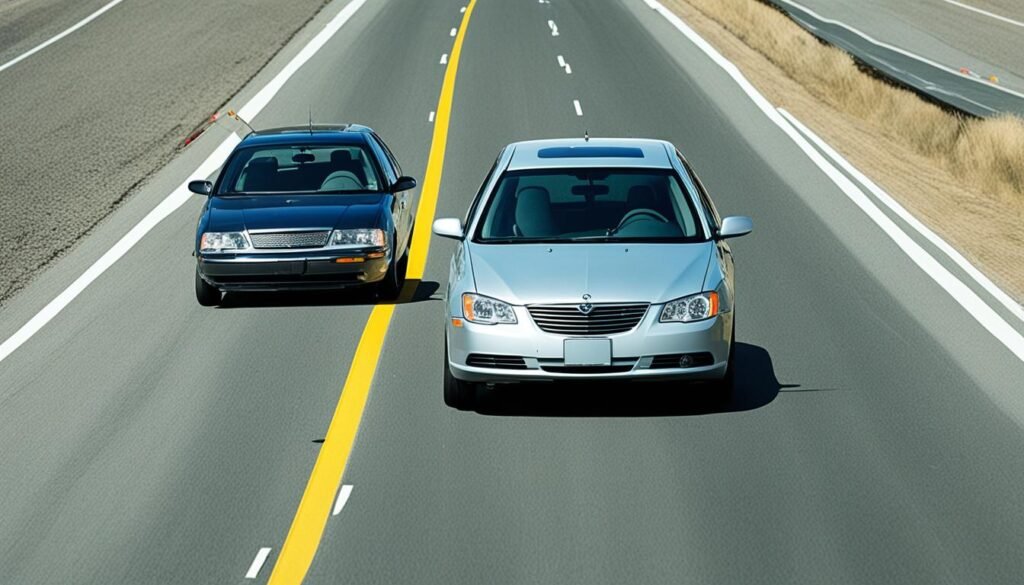Rear-end collisions are involved in about 29% of all highway traffic accidents in the U.S. They represent nearly a third of all accidents. These collisions can lead to serious injuries, damage to property, and legal issues. It’s vital for drivers and victims to understand these accidents for justice and compensation.
Key Takeaways:
- Rear-end collisions make up nearly 29% of all traffic accidents on highways.
- These collisions can result in severe injuries, property damage, and legal implications.
- Understanding the causes and determining fault is crucial for seeking compensation.
- Advanced braking systems can significantly reduce the risk of rear-end collisions.
- Driver behavior, such as inattention and poor decision-making, plays a major role in these accidents.
The Impact of Advanced Braking Systems on Rear-End Collisions
A study by the Insurance Institute for Highway Safety (IIHS) shows important findings. It says large trucks with forward collision warning and automatic emergency braking (AEB) systems could cut rear-end collisions by more than 40%. These technologies use cameras, radar, or sensors to keep an eye on the road ahead. They warn drivers and brake automatically to avoid crashes.
The study examined data from 62 carriers with big trucks. It found that trucks with forward collision warning had 22% fewer crashes. Trucks with AEB had 12% fewer crashes compared to those without these safety features. Having these systems on all new big trucks could greatly lower the risk of rear-end collisions.

These advanced braking systems are key in reducing rear-end collision effects. They give early warnings and automatically brake the vehicle. This helps drivers avoid crashes or lessen the crash impact. This tech is extra helpful for big trucks because they need more time to stop than smaller vehicles do.
The IIHS study underlines how effective these advanced braking systems are at cutting down rear-end collisions. It shows why it’s crucial for the trucking industry to use these systems more widely. By putting more trucks with this tech on the road, we can cut down injuries, deaths, and property damage from rear-end collisions.
“We found that trucks equipped with forward collision warning alone had a 22% lower crash rate. Trucks with AEB had a 12% lower crash rate compared to trucks without either system.”
Putting advanced braking systems in trucks isn’t just about safety. It also brings financial benefits for trucking companies. These companies can spend less on repairs, insurance, and legal costs by avoiding rear-end accidents. Making safety a priority also improves their reputation and can bring in more customers.
Advantages of Advanced Braking Systems in Rear-End Collisions:
- Reduction in rear-end collisions by more than 40%
- Early warnings and automatic braking to prevent collisions
- 22% fewer crashes for trucks with forward collision warning
- 12% fewer crashes for trucks with AEB
- Improved safety and reduced severity of collisions
- Savings on repair costs, insurance premiums, and legal expenses
Launching these cutting-edge technologies marks a key progress in stopping rear-end collisions and boosting road safety. Nevertheless, trucking companies and policymakers must collaborate. They need to ensure these systems are included in new trucks. Doing so will make our roads safer for all of us.
Factors Contributing to Rear-End Collisions
Drivers not paying attention or making bad choices cause about 66% of truck rear-end crashes. Meritor Wabco Vehicle Control Systems have shown the driver’s actions are key in avoiding these crashes. One main cause of such accidents is drivers not slowing down when they should.
For instance, going too fast in bad weather or busy traffic can lead to more rear-end crashes. Another big issue is tailgating. This happens when drivers don’t leave enough space between their vehicle and the one ahead.
They then can’t stop in time if the vehicle in front slows down or stops. This often leads to rear-end collisions. Giving drivers just one more second to react could stop 90% of rear-end crashes. This shows how crucial it is to drive carefully.
Driver Education and Awareness Programs
Teaching drivers properly plays a big role in reducing rear-end crashes. Programs focus on teaching safe driving habits like keeping a good distance from the car ahead. They also teach how to spot dangers and adjust speed based on road conditions. Through these efforts, drivers learn how to avoid causing a rear-end crash.
Integration of Advanced Braking Technologies
Teaching drivers is important, but advanced braking tech also helps a lot. Automatic emergency braking (AEB) can see a crash coming and brake by itself. This tech uses sensors, cameras, or radar to keep an eye on the road and acts to prevent crashes.

Adding these technologies to vehicles can make rear-end crashes less likely. While drivers must still drive safely, these systems offer extra safety. This can be especially useful when a driver’s reaction timing isn’t great.
Both education and high-tech braking systems work together to prevent rear-end crashes. This two-pronged approach tackles the problem by improving driver behavior and using safety technology. The aim is to lower the number of these accidents.
| Contributing Factors to Rear-End Collisions | Percentage |
|---|---|
| Inattention or poor decision-making | 66% |
| Driving too fast for conditions | 42% |
| Following too closely | 58% |
The Role of Regulations and Legislative Measures
The National Highway Traffic Safety Administration (NHTSA) plans to update the Federal Motor Vehicle Safety Standard (FMVSS) 121. This would make trucks stop quicker. These changes push for more advanced braking tech like air disc brakes. Companies making brakes are already adding these systems to boost safety.
New laws are helping bring in better safety tech for trucks. Things like stability control and adaptive cruise control are getting more common. These steps are key in making brakes better. They help trucks avoid rear-end crashes.
The Business Case for Advanced Braking Systems
Regulatory requirements and safety are key reasons for using advanced braking systems. Yet, there’s also a big business benefit for fleets. Accidents cause direct costs, like equipment repairs and downtime, and indirect costs, like hurting the fleet’s name and losing business. Advanced braking systems cut costs from accidents, boost fuel efficiency, and make the fleet safer overall. This tech investment saves money and raises profits for fleet owners.
The Benefits of Advanced Braking Systems for Fleet Operators
Let’s look at the benefits of advanced braking systems:
- Reduced Accident-related Costs: These systems can prevent crashes, saving on repair costs and downtime. This means savings for fleet owners.
- Improved Fuel Efficiency: By better braking and less unnecessary braking, these systems save fuel. This cuts operational costs and is good for the planet.
- Enhanced Safety Performance: Using advanced braking systems shows a commitment to safety. This can strengthen client relationships, build trust, and open new business doors.
- Reduced Liability: Fleets with these systems can show they’re proactive about safety. This can lower accident liability and positively affect insurance rates.
By looking at both direct and indirect accident costs, fleet operators see a strong reason to invest in advanced braking systems. The benefits and cost savings in the long term are worth the initial cost, offering a great return on investment.
Case Study: XYZ Trucking Company
“Advanced braking systems changed the game for our fleet. We’ve seen fewer rear-end crashes and accidents, saving on repair and insurance costs. Our drivers are more confident and safer, boosting our reputation and attracting new clients. We suggest other fleet operators invest in advanced braking systems.”
Conclusion
Rear-end collisions on highways are dangerous for truck drivers and people in cars. Knowing the causes helps reduce these accidents. By using better brakes and driving safely, we can lower the risk.
The law plays a big role in dealing with rear-end collisions. Super Attorneys Of Irvine helps victims get money for their injuries. They connect victims with the best lawyers for their case.
Need expert legal help? Call Super Attorneys Of Irvine at 949-996-9546. Or visit //businesslawyersirvine.com/. They can guide you in getting the compensation you need.

